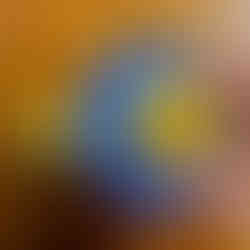Wild Violet Jelly (vegan)
- ambervriends
- Jun 19, 2024
- 6 min read
Updated: Sep 25, 2024
Add a taste of spring to your toast! This beautifully colored flower jelly has a surprising flavor that resembles berries and honey, and is very easy to make.

WILD VIOLET
The humble wild violet is a plant with purple flowers that you can encounter blooming in the early spring. These little plants like the cooler season before the heat of the summer, and this is when they really thrive. Wild violets belong to the genus Viola, which consists of over 500 species. You can find violets growing almost anywhere, from woodlands to rocky hillsides, along roadsides and riverbanks, in meadows and marshes. Violet's delicate flowers range in color from blue to varying shades of purple, as well as white and yellow. Two of the best known wild species that we will focus on in this article are the common blue violet (Viola sororia) and wood violet (Viola odorata). These two species look much alike, and both have edible flowers and leaves.
These days a lot of people like to create uniform lawns around their houses with only grass (which sadly creates small-scale ecological deserts). Violets are perennials and one of the ways they reproduce is by creating underground rhizomes. This makes them tough to eradicate from lawns. For this reason, many people are not happy to see them when they show up. However, welcoming wild violets into your yard (as well as other wild plants like clover and dandelion) is a great way to support local biodiversity. Their flowers serve as an early source of nectar for pollinators like bees and butterflies when few other food sources are available, and their nutritious leaves are food source for a variety of animals. As you will see, another reason to embrace wild violets is that they offer us humans some special gifts too.

Until not so long ago, humans all over the world had a strong connection with violets. In ancient Rome, violet flowers were considered a symbol of grief and innocence, and were often placed on the graves of children and babies. In one of the Greek myths, Zeus had turned a nymph named Io, whom he loved, into a cow to hide her from his wife Hera. Io grieved her human life she had lost, so Zeus turned her tears to violets to comfort her. During the Middle Ages, violets were used to signify chastity and fidelity in love. Lovers would often exchange violets to express their love and devotion. Napoleon Bonaparte was also very fond of violets, so much so that they became his personal emblem and a flower he often gave to his wife. While in exile on Elba he told his friends he would return when the violets would bloom in the spring. When he returned after his escape in 1815, admirers threw violets across his path, and the violet became an public symbol to show support.
Throughout time, violets have been regarded by many as a symbol of grief, innocence, modesty, and love. Another reason why humans have treasured wild violets for centuries, is because of their special medicinal qualities. Violets have important healing properties for our lungs, offering relief for inflammation and infection of the respiratory tract, as well as for colds, congestion, and the flu. Wild violets can also help relieve symptoms of high blood pressure, bladder infections, rheumatoid arthritis, acne, psoriasis, warts, and eczema. There are even accounts of the different indigenous peoples of Turtle Island (North America) using violet for certain types and aspects of cancer treatment, which more recent research studies now also support.
FINDING WILD VIOLET
Wild violets can be found in the temperate regions of the Northern Hemisphere. They grow in many different environments, including forests, meadows, riverbanks, and gardens. They are some of the first flowers to bloom in the spring, covering roadsides and lawns with their tiny flowers. They are beautiful when in bloom, however as the temperatures warm up with the arrival of summer, the flowers tend to wilt. Wild violets like to start growing in shady areas, but will spread to sunnier locations if conditions are favorable. They prefer moist, richer soils that are slightly acidic.
The wood violet (Viola odorata) is native to Europe and Asia, but humans have also introduced the plant to Turtle Island (North America) and Australia. The common blue violet
(Viola sororia) finds their origins on the Eastern part of Turtle Island. So which one you are most likely to encounter depends on where you live.

Wild violets have distinctive purple flowers. The flowers are small and delicate, and have five petals that are arranged in a distinctive pattern. The inside of the flower is white. Interestingly, even though the plants go through the effort of creating flowers to attract pollinators, their flowers often don't produce seeds because they bloom before many pollinators are active. However, the wild violet has found a solution by developing a second type of flower (which is closed, or 'cleistogamous'). These flowers are more effective at seed production. They grow near or beneath the ground, shielded by the violet's leaves, and don't open but instead self-pollinate. When the seeds are mature, the flowers burst open to release them.

Wild violets usually grow 15 to 25cm (6 to 10 inches) tall, depending on their geographical location, humidity, and the quality of the soil they grow in. The leaves of wild violets are heart-shaped, slightly serrated at the edges, and grow in a rosette pattern. Their root systems include rhizomes, which aid in the plant's asexual reproduction as well as nutrient storage.
While all violet species are edible, wild violets have some lookalikes that are inedible or poisonous. It is therefore important to only harvest them when you are sure you have found your humble purple friend! Lesser celandine (Ficaria verna) is a toxic plant whose leaves look very similar to those of wild violets (but has yellow flowers). If this plant grows where you live, it is important to only harvest when their flowers are present so you can easily distinguish the two. Good quality plant identification guidebooks can help you determine what potential other lookalikes you might need to watch out for in the area you live in.
HARVESTING & PROCESSING WILD VIOLET
Before you start foraging, remember that when you harvest wild violets or any other beings in nature, it’s important to walk softly on the Earth and to forage with care. We humans are guests and receivers of the gifts of nature, so always consider how you can do this respectfully. Please only take what you need and leave plenty.
When you harvest wild violets, do this in a gentle and mindful way. The plants are rather delicate, and you want to make sure to not damage the plant or underground root system. You can use scissors or your fingers to carefully snip the flower or leaf from the plant. Because the flowers are so small and we don't want to take too much from each plant, harvesting a few handfuls of flowers can take a bit of time. A great opportunity to slow down, be mindful, and develop a relationship with this special plant companion!

Ideally, you use the flowers (or leaves) immediately after harvesting. If this is not possible, you can preserve them for later use by laying them out in a single layer on a clean surface to dry thoroughly. You can also use a dehydrator to speed up the process. After this you can store them in a dry and dark location.
Both the wild violet flowers and leaves are edible, and can be used in many ways. The leaves are rich in vitamins A and C, and can be eaten raw in salads, wraps, or on sandwiches. They can also be cooked as greens, added to soup, or used in a pesto. The flowers can be used to make jelly like we are doing today, tea, syrup, candy, or added to a salad or pancakes as a decoration. Wild violet roots should not be eaten as this can cause gastrointestinal discomfort.

VISUAL GUIDE FOR WILD VIOLET JELLY RECIPE
Now that you have learned all about wild violet, let's make some jelly. It's very easy! The images below show you the process that is described in the recipe. You can also watch the video to see the wild violet flower infusion magically turn from blue to pink in just a few seconds!
Because of local availability challenges, when I made this recipe myself I had to use liquid pectin for the jelly. I however mentioned powdered pectin in the recipe instead, since this is easier to use and requires less sugar.
WILD VIOLET JELLY RECIPE
Disclaimer: Every year there are people that are poisoned or experience other negative health effects from eating inedible wild plants or mushrooms that resemble edible species. For this reason it's essential to ensure proper species identification and to consult multiple quality sources for doing this. It's also important to consider your unique health considerations before consuming wild foods. Always check and follow all local foraging regulations before you harvest anything in nature.























Comments